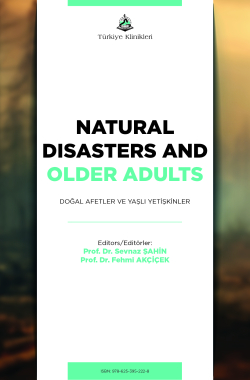Post-Disaster Physiotherapy Approach for Older Adults
Serkan BAKIRHANa , Mehmet ÖZKESKİNa
aEge University Faculty of Health Sciences, Department of Physiotherapy and Rehabilitation, İzmir, Türkiye
Bakırhan S, Özkeskin M. Post-disaster physiotherapy approach for older adults. In: Şahin S, Akçiçek F, eds. Natural Disasters and Older Adults. 1st ed. Ankara: Türkiye Klinikleri; 2024. p.58-63.
ABSTRACT
Disasters are natural events that humans cannot prevent and many of which are unpredictable. Earthquakes, floods, fires are important disaster events. In disaster situations, it is important to evaluate the general rehabilitation needs and make quick planning. Children, those with chronic diseases and the elderly are the most vulnerable groups that are most affected by disasters. It is important to raise awareness about the needs and rehabilitation services of elderly individuals with chronic diseases during a disaster. Therefore, physiotherapists have important duties. Physiotherapists should increase the rehabilitation services and independence levels of elderly individuals by contacting local governments during these periods. Most of the injuries that occur following disasters are of orthopedic nature and are the main causes of musculoskeletal and soft tissue injuries and hospitalizations. Amputations, tissue crushing, fractures and nerve injuries cause significant loss of function in elderly individuals. For this reason, post-disaster physiotherapy approaches have an important place in elderly individuals.
Keywords: Disaster; physiotherapy; elderly
Kaynak Göster
Referanslar
- Şahin Ş. Türkiye'de afet yönetimi ve 2023 hedefleri. Türk Deprem Araştırma Dergisi. 2019;1(2):180-96. [Crossref]
- Açkın B, Tokem Y. Afetlerde geriatrik yaklaşım. İzmir Kâtip Çelebi Üniversitesi Sağlık Bilimleri Fakültesi Dergisi. 2023;8(2):653-9.
- İnce C. Afetlerde sosyal savunmasız bir grup olarak yaşlılar: Covid-19 örneği. Avrasya Sosyal ve Ekonomi Araştırmaları Dergisi. 2020;7(9):184-98.
- Barusch AS. Disaster, vulnerability and older adults: Toward a social work response. Journal of Gerontological Social Work. 2011;54(4):347-50. [Crossref] [PubMed]
- Çakır Ö, Atalay G. Afetlerde özel gereksinimli grup olarak yaşlılar. Resilience. 2020; 4(1):169-86. [Crossref]
- Maltais D. Elderly People with disabilities and natural disasters: vulnerability of seniors and post Trauma. J Gerontol Geriatr Med. 2019:5: 041. [Crossref]
- Erden Z, Yıldız TY. Afet yönetiminde ve afete bağlı yaralanmalarda fizyoterapistlerin rol ve görevleri. İzmir Kâtip Çelebi Üniversitesi Sağlık Bilimleri Fakültesi Dergisi 2023; 8(2):835-43.
- Trivedi N, Rathod P. Physiotherapy in disaster management: physiotherapist view. Natl J Integr Res Med. 2017;8(4):32-4.
- World Confederation for Physical Therapy. WCPT Report: The role of physical therapists in disaster management. [homepage on the internet]. London, UK: WCPT; March 2016. [Accessed on: 2023 February 20]. Available from: [Link]
- Landry MD, O'Connell C, Tardif G, Burns A. Post-earthquake Haiti: the critical role for rehabilitation services following a humanitarian crisis. Disabil Rehabil. 2010;32(19):1616-18. [Crossref] [PubMed]
- Karunakara U, Stevenson F. Ending neglect of older people in the response to humanitarian emergencies. PLoS medicine. 2012:9(12), e1001357. [Crossref] [PubMed] [PMC]
- Khan F, Amatya B, Gosney J, Rathore FA, Burkle JFM. Medical rehabilitation in natural disasters: a review. Arch Phys Med Rehabil. 2015;96(9):1709-27. [Crossref] [PubMed]
- Uz I, Çetin M, Songur Kodik M, Guvenc E, Karbek Akarca F, Ersel M. Emergency department management after the 2020 Aegean Sea-İzmir earthquake. Ulus Travma Acil Cerrahi Derg. 2022;28:361-8. [Crossref] [PubMed] [PMC]
- Ceylan MF, Serbest S, Güven N. Deprem yaralanmaları ve ampütasyon, gözlemlerimiz ve önerilerimiz. TOTBİD Dergisi 2022;21:325-32. [Crossref]
- Kaçmaz KE, Polat K, Uçurum SG. Depremle İlişkili Rabdomiyaliz Geçiren Hastada Ampute Rehabilitasyonu. İzmir Kâtip Çelebi Üniversitesi Sağlık Bilimleri Fakültesi Dergisi. 2023;8(2):635-40.
- Clark D, Nakamura M, Miclau T, Marcucio R. Effects of Aging on Fracture Healing. Curr Osteoporos Rep. 2017;15(6):601-8. [Crossref] [PubMed] [PMC]
- Güneş M, Güneş A, İlbeyli N, Kaya B. Asbest Maruziyeti ve Etkileri. Türk Bilimsel Derlemeler Dergisi. 2017:10(1):1-5. [Crossref]
- Lathia C, Skelton P, Clift Z (Eds). Early rehabilitation in conflicts and disasters. [homepage on the internet]. 1st Edition, January 2020. (Accessed on: 2023 June 1). Available from: [Link]
- He CQ, Zhang LH, Liu XF, Tang PF. A 2-year follow-up survey of 523 cases with peripheral nerve injuries caused by the earthquake in Wenchuan, China. Neural Regen Res. 2015;10(2):252-9. [Crossref] [PubMed] [PMC]
- Ahrari MN, Zangiabadi N, Asadi A. Prevalence and distribution of peripheral nerve injuries in victims of Bam earthquake. Electromyogr Clin Neurophysiol. 2006;46(1):59-62
- Amatya B, Vasudevan V, Zhang N, Chopra S, Astrakhantseva I, Khan F. Minimum technical standards and recommendations for traumatic brain injury rehabilitation teams in sudden-onset disasters. J Int Soc Phys Rehabil Med. 2018;1(2):72-94. [Crossref]
- Kurultak İ. Deprem yaralanmalı erişkin hastada Crush sendromu. TOTBİD. 2022;21:294-303. [Crossref]
- Dağlar B. Deprem yaralanmalı hastada kompartman sendromu. TOTBİD. 2022;21:283-8. [Crossref]
- Sahebi A, Nejati-Zarnaqi B, Vasei N, Jahangiri K. Deep Vein Thrombosis after earthquake: a systematic review and meta analysis. Disaster Med Public Health Prep. 2023;17:e304. [Crossref] [PubMed]
- Sakuma M, Nakamura M, Hanzawa K, Kobayashi T, Kuroiwa M, Nakanishi N, et al. Acute pulmonary embolism after an earthquake in Japan. Semin Thromb Hemost. 2006;32(8):856-60. [Crossref] [PubMed]
- Palmer G. Complex regional pain syndrome. Aust Prescr. 2015;38(3):82-6. [Crossref] [PubMed] [PMC]

